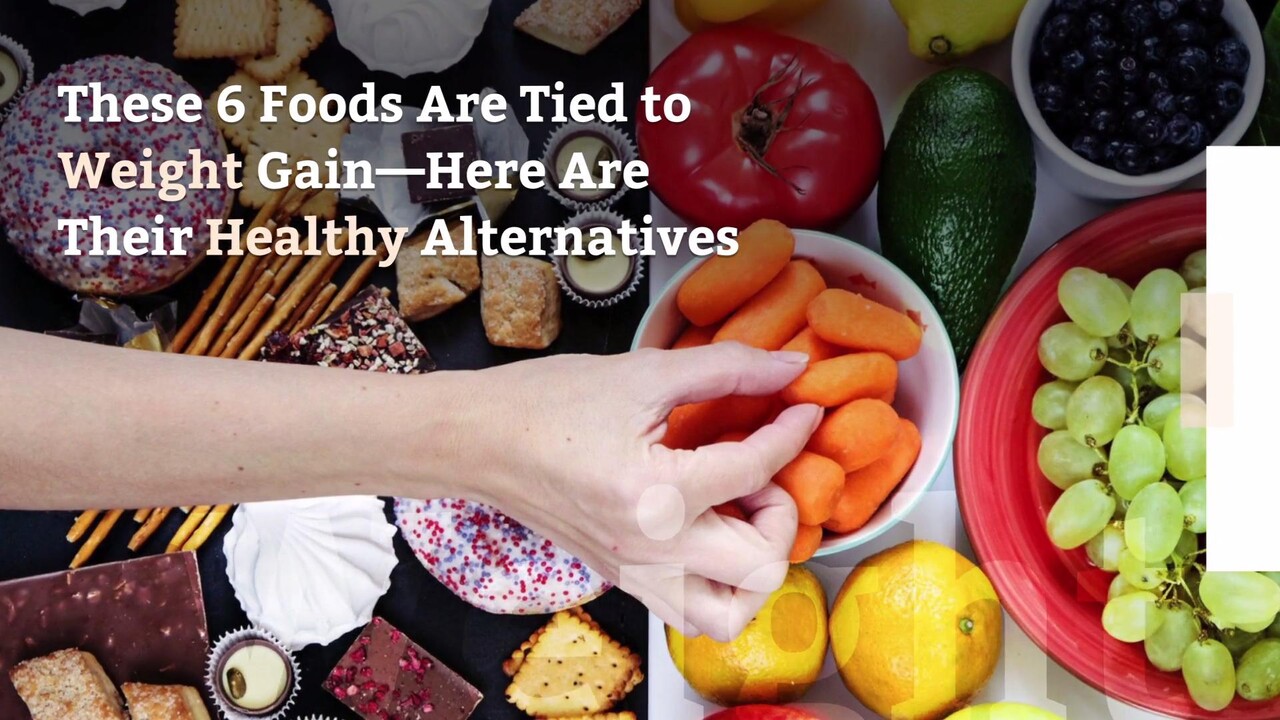These 6 Foods Are Tied to Weight Gain—Here Are Their Healthy Alternatives
There’s no one-size-fits-all when it comes to losing weight. But, according to a new study from researchers at George Washington University, some foods are more closely associated with weight gain than others.
And a trio of plant-based foods appears to be tied to weight loss. That means zeroing in on a short list of commonly eaten foods—some to minimize, and others to increase—could play an important role in helping you achieve and maintain better weight management results.
Here are better-for-you alternatives to the top six foods connected to weight gain, along with advice for how to up your intake of the top three foods known to keep pounds at bay: whole grains, vegetables, and fruits. Even if you’re not trying to lose weight, these exchanges can increase your energy, enhance your mood, improve digestive health, and lower your disease risk. And they’re simple. Ready to switch things up?
RELATED: The 12 Best Weight-Loss Tips, According to a Nutritionist
Potato chips
DIY it. Potato chips are made with three simple ingredients: sliced potatoes (a whole food), oil, and salt. Part of the problem with store-bought chips is the type of oil used. The high omega-6 fatty acid oils used for frying chips—including sunflower, safflower, and corn oil—have been associated with fueling inflammation, particularly when not balanced with anti-inflammatory omega-3 fatty acids.
Frying is another strike, as cooking starchy foods to very high temperatures has been shown to trigger the formation of acrylamide, a chemical linked to aging and increased cancer risk.
For a healthier version, thinly slice a skin-on potato, lightly toss in extra virgin olive oil (EVOO) or avocado oil, along with a little sea salt and black pepper, and cook on a baking sheet at 400 degrees F. And if, like me, you just can’t resist grabbing an occasional bag of ready-to-eat chips, opt for those made with avocado or EVOO, which are high in heart-protective monounsaturated fats.
RELATED: Health Benefits of Celery
Sugar-sweetened beverages
Artificially sweetened drinks are no better than those made with real sugar, and they may actually be worse for your waistline. Some scientists say that faux sugars activate the brain's pleasure center without satisfying it, which triggers an increased desire for sweets. That’s likely why statistically, people who drink diet beverages aren’t slimmer. One report found that two-can-a-day diet drinkers had a 54.5% chance of becoming overweight or obese, compared to 32.8% for those who drank the same amount of regular soda.
The best option for weight management and health is to ditch both varieties. If you prefer a bubbly beverage, reach for an all-natural flavored sparkling water.
Better yet, fill up a daily pitcher with 64 ounces of filtered water that's been infused with all natural add-ins to impart nutrients and flavor, such as sliced cucumber, mint, citrus, ginger root, or other bits of slightly mashed fresh fruit. Sip on it throughout the day to stay hydrated, skirt sweeteners, and avoid any artificial additives.
RELATED: The Best (and Worst) Diets of 2020
Sweets and desserts
It’s not realistic to go through the rest of your life avoiding sweets altogether. But, most people are eating far more than the minimum recommended for wellness and disease prevention. According to the American Heart Association, women should consume no more than six teaspoons worth of added sugar per day, and men no greater than nine.
A grande size Frappuccino from Starbucks can easily pack over 15 teaspoons of sugar, mostly the added variety—meaning not the sugar naturally found in milk straight from the cow, but the kind that’s added in the form of table sugar and corn syrup.
To curb your intake, set up a sweets strategy. First, identify your can’t-live-without goodies. For example, maybe you can forego the half-stale donuts in the office break room, but you want to occasionally enjoy your favorite flavor of ice cream. Consider limiting must-have goodies to once or twice a week. And on the daily, enjoy a few squares of 70% dark chocolate. Each square typically contains just a half teaspoon of added sugar, and research has shown that building in dark chocolate as a daily treat can boost happiness, protect your heart, and curb cravings for both sweet and salty foods.
RELATED: 7 Dangers of Going Keto
Refined grains
These days, you can find a whole-grain version of just about everything, from bread to pasta, rice, cereal, crackers, and wraps. Just be sure to read ingredient lists to avoid being tricked by versions that are only partially made with whole grains, as these have been combined with traditional refined flour. Another option is to upgrade to veggie-based alternatives, which provide fewer calories and carbs, plus more fiber, nutrients, and antioxidants. Or go half and half. For example, toss a smaller portion of brown rice with riced cauliflower, or mix spiralized veggies or spaghetti squash with a small portion of pasta made from quinoa flour. Or use sliced, toasted sweet potato in place of bread for sandwiches, or to slather with avocado, hummus, or nut butter.
Red meats
Red meats include beef, as well as pork, veal, lamb and mutton, venison, goat, and buffalo. The American Institute for Cancer Research advises limiting red meat to no more than 18 ounces per week. If you typically eat six-ounce portions, that means a cap of three meals per week.
Trade red meat for low-mercury seafood, organic poultry, or plant-based options. For weight loss, your best bet is to replace meat with pulses, the umbrella term for beans, lentils, peas, and chickpeas. In addition to being affordable, filling, high in fiber, nutrient-rich, and naturally gluten-free, pulses have been shown to support healthy weight management, including a reduction in waist measurements.









Comments
Post a Comment